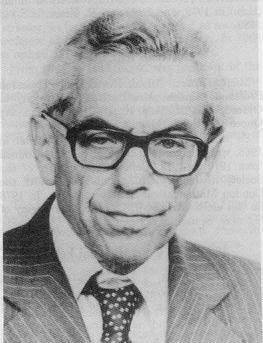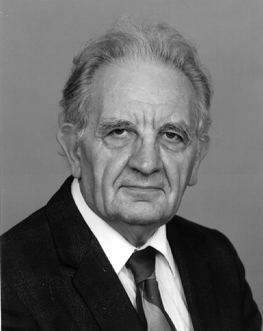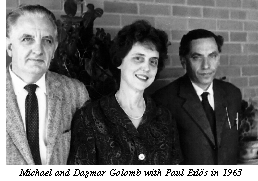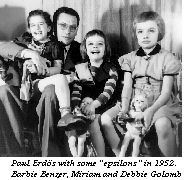 Paul Erdös, one of the greatest mathematicians of this century, died September 20 in Warsaw while attending an international conference on combinatorics. He was 83 years old.
Paul Erdös, one of the greatest mathematicians of this century, died September 20 in Warsaw while attending an international conference on combinatorics. He was 83 years old.
 Paul Erdös, one of the greatest mathematicians of this century, died September 20 in Warsaw while attending an international conference on combinatorics. He was 83 years old.
Paul Erdös, one of the greatest mathematicians of this century, died September 20 in Warsaw while attending an international conference on combinatorics. He was 83 years old.
In spite of what he called his "enormous age," Erdös was still traveling all over the globe, as he had done throughout his adult life, from one conference to another, stopping on his way at hundreds of mathematical centers to lecture and work with the ever growing number of his collaborators. Even in his late years, he was still authoring and co-authoring dozens of papers every year. He was probably the most prolific mathematician ever; by the time of his death, his publication list (articles and books) totaled about 1500.
Paul Erdös has been honored all over the world with memberships in national academies, honorary degrees, conferences and commemorative volumes dedicated to him, and several prizes, among them the prestigious Wolf Prize of Israel. Undoubtedly, in the near future memorials appraising his work and life will appear in many mathematical journals.
 Purdue played a particular role in Erdös's life and I, who shared several years of his stay here and became his friend, am privileged to report about it. As far as I know, there are only two American universities where Erdös had regular, salaried positions-Purdue and Notre Dame. He held the appointment of Research Associate in our department from 1943 to 1945, a position that required no teaching duties and as such was unique in our department, before and ever since. It is possible that his salary did not come from the department's budget, but from the Purdue Research Foundation.
Purdue played a particular role in Erdös's life and I, who shared several years of his stay here and became his friend, am privileged to report about it. As far as I know, there are only two American universities where Erdös had regular, salaried positions-Purdue and Notre Dame. He held the appointment of Research Associate in our department from 1943 to 1945, a position that required no teaching duties and as such was unique in our department, before and ever since. It is possible that his salary did not come from the department's budget, but from the Purdue Research Foundation.
Purdue established a practically new mathematics department in the early 40's. In 1941 the department acquired a new Head, W.L. Ayres, a young topologist, who had been an associate professor at the University of Michigan. The department had up to that time been solely a service department, mainly for the teaching of the large number of engineering students. The majority of the faculty were not Ph.D.'s, and no graduate courses were taught. President Elliott appointed Ayres with the specific mandate to build a first rate mathematics department with a research oriented teaching staff and a broad graduate program up to and including the Ph.D. level. In his first two years as Head, Ayres appointed about a dozen young, promising mathematicians-all of them, with a few exceptions like myself, recent Ph.D.'s from prestigious universities. Erdös's appointment came in 1943, the last year of this expansion, which came to an end because of the country's war exigencies.
 Before Erdös's arrival, there was not a single established mathematician in the department to give guidance to the group of young, talented, but inexperienced mathematicians, whose only research work so far had been their Ph.D. theses. Also, they all had studied different specialties and could be of little help to each other. Their teaching loads were heavy, some up to 15 hours, some in graduate courses that they had to design themselves. Erdös, not yet 30 years old, was by far the most knowledgeable and creative mathematician on the campus, with at least thirty very substantial publications to his name, some jointly authored with mathematicians of international fame. By his very presence he transformed the existing mathematical desert into a fertile field of great promise. He taught no class, but he ran the only research seminar in the department, on interpolation theory, to which he was making significant contributions at that time. We all attended this seminar, but none of us was prepared to work with him on these difficult problems that required vast knowledge of previous work by many mature mathematicians.
Before Erdös's arrival, there was not a single established mathematician in the department to give guidance to the group of young, talented, but inexperienced mathematicians, whose only research work so far had been their Ph.D. theses. Also, they all had studied different specialties and could be of little help to each other. Their teaching loads were heavy, some up to 15 hours, some in graduate courses that they had to design themselves. Erdös, not yet 30 years old, was by far the most knowledgeable and creative mathematician on the campus, with at least thirty very substantial publications to his name, some jointly authored with mathematicians of international fame. By his very presence he transformed the existing mathematical desert into a fertile field of great promise. He taught no class, but he ran the only research seminar in the department, on interpolation theory, to which he was making significant contributions at that time. We all attended this seminar, but none of us was prepared to work with him on these difficult problems that required vast knowledge of previous work by many mature mathematicians.
Within a few months, however, he succeeded in drawing these novices into new, and for them untried, territories, with his vast fund of problems and conjectures that he was eager to share with his young colleagues. Evidence for this shows in the goodly number of papers that he co-authored with them in a short time. Most mathematicians have heard of the "Erdös number," defined (originally by Casper Goffman) as the smallest number of chain links (by co-authorship) between some mathematician and Erdös. If you have a joint publication with Erdös, your E-number is 1. Your E-number is n + 1 if you are a joint author with someone whose E-number is n, but not with someone whose E-number is less than n. Of course, Erdös is the only person whose E-number is 0. Of the people in our small 1942 Purdue group, there are no fewer than four that have the prestigious E-number 1: Leon Alaoglu, Ivan Niven, Arthur Stone, and myself. Some of these co-authored more than one paper with Erdös later on, which proves the beneficial influence of the master on his disciples.
What impressed people most about Erdös was that he was so totally immersed in mathematics that nothing else in life seemed to matter to him. But this is not true, at least not in his younger years. While he meant much to our group because of his mathematical genius, he also contributed greatly to our social life. We all felt socially deprived, confined to the small town in a midwestern agricultural state, far from cosmopolitan centers. Now we had among us this man, with his past from European cultural centers, his intimate acquaintance with internationally known mathematicians, but also his wide interest in scientific culture and world politics. To give a glimpse of this side of his personality, I mention a couple of reminiscences.
The young group of mathematicians, together with some kindred spirits in physics and chemistry, would gather once a week for some cultural event, followed by social entertainment. Most of the time one of the group would report on a recent article or book he had read, which often led to a lively discussion. One of these evenings, the colleague who was to be the speaker did not show up, and no other program had been prepared. Erdös himself offered to speak. Extemporaneously, without the aid of notes, he gave a fascinating report about some recent research on the color vision of bees. We were enchanted and surprised by this performance; we had not expected that Paul had any interest in such matters.
Erdös was a skillful player of chess (and Go). Many chess games went on in the hallway of our building during periods of relaxation. The best chess player in the department was Nat Fine, a recognized local master, whom Erdös could beat only rarely, usually by psychological warfare. Once I walked by the place where they were playing, and I saw Nat with his head between his hands, deep in thought considering the next move, while Erdös seemed to be engrossed in studying a voluminous encyclopedia of medicine, which he held in his lap (Erdös was from early on deeply interested in medicine). I asked him, "What are you doing, Paul? Aren't you playing against Nat?" His answer was, "Don't interrupt me, Michael. I am proving a theorem."
Erdös's ties with Purdue did not end with the termination of his employment. In subsequent years, he held a tenured professorship at Notre Dame, but he felt more at home with his friends and colleagues at Purdue. He spent almost as much time in Lafayette as in South Bend. He did not rent an apartment there, but lived in a hotel room during the week and regularly came back to Lafayette on weekends, where he stayed with his friends, shared meals with their families, had his laundry and mending done by their "bosses" (wives), and so on. This may sound as if he was wont to exploit his friendships, but this is deceiving. His friends gave their services gladly; they knew that Erdös was a helpless child in the daily affairs of life. They also knew that Erdös was a most generous man; he never hoarded the money he made from his appointments and lecture engagements, but gave it away to organizations that he thought needed his support, and mostly to students and young colleagues whom he wanted to promote.
Another story comes to my memory when I think of Erdös's humanity. In 1945, when I was in Philadelphia at the Franklin Institute doing war service for the government, I received in my office one day a telephone call from Erdös. He was passing through and wanted to meet me and my wife. I told him I was to be at a party that evening at the home of one of my colleagues, located in one of the northern suburbs of Philadelphia. I also told him that he would be welcome at the party and that my colleague often had expressed the wish to meet the famous Erdös. I gave him the address and directions to get there. It so happened that while Erdös was on the bus that was taking him to my friend's house, my colleague, the host of the party, was going home on the same bus. He saw the strange man getting up from his seat, walking rapidly up and down the bus again and again, and he guessed this might be Erdös. He went up to him and asked, "Are you Dr. Erdös?" The answer was, "How is Golomb?" Well, my colleague took him to his home and wanted to introduce him to the guests, but Erdös saw me first and talked to me in a private corner for awhile. I rejoined the party, but Erdös disappeared somewhere and we did not see him for the rest of the evening. Only when everyone was ready to leave did we learn that Erdös had found out that our host had a blind father, who could not join the party, but sat up in a room on the upper floor. Erdös preferred spending the time with the lonely blind man rather than with the people in the party, who were eager to meet him.
During the years when Erdös was again allowed to visit "Sam" (the United States), he returned several times to Purdue to visit his friends and to give colloquium lectures. The last time was in December 1993, when he gave a talk entitled "My Favorite Problems and Theorems" to a large and appreciative audience. It was fascinating to watch the 80 year old man perform astounding feats of memory. He stated dozens of problems, conjectures, results, the years in which they were conceived, solved, generalized, and published. He named dozens of contributors, all without the aid of notes, directly from memory.
Erdös was invited to Purdue this year to receive an honorary degree. In his reply to President Beering, he stated that he had spent many a pleasant year at Purdue and that he had many friends there. He could not accept the offer this year because of previous commitments in France and Germany. The invitation was then renewed for the coming year, and Erdös agreed to come then. Alas, this was not to be.
Erdös was the most loyal of friends. His friendship extended not only to his professional colleagues, but usually also to their families. After we had become friends, he insisted on meeting my sister and her family in California, my brother in Israel, and my other brother in Massachusetts. In his frequent greeting card messages and long distance calls from all the places he visited, he never forgot to ask about our "epsilons" (children) and later on about "epsilon squared" (grandchildren). We had been looking forward to seeing him again at Purdue. We miss him sorely, like the closest of family.
